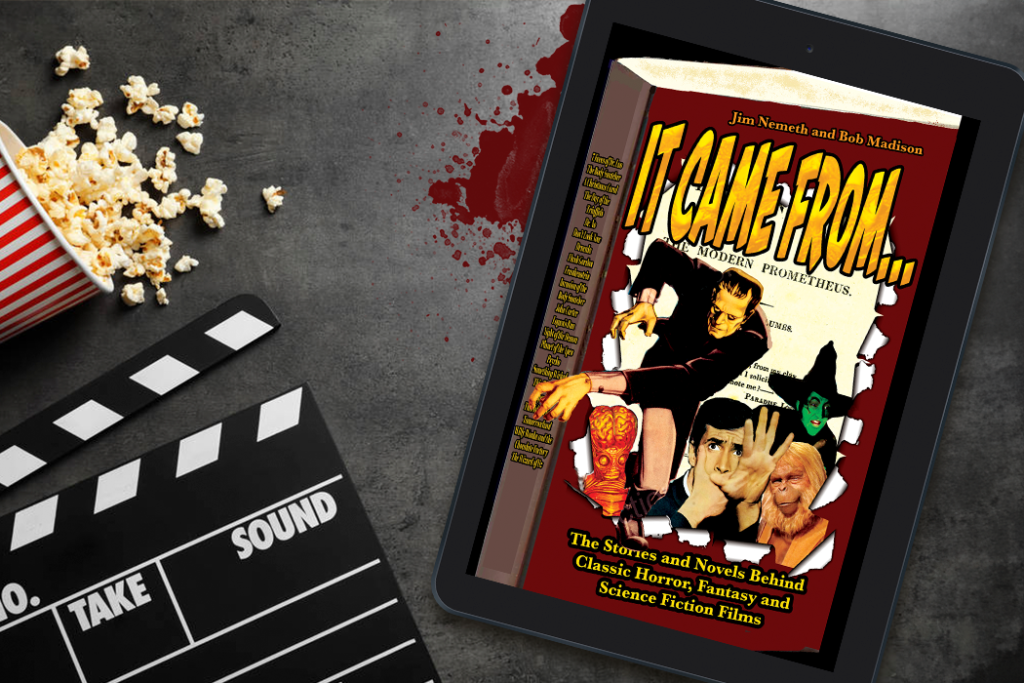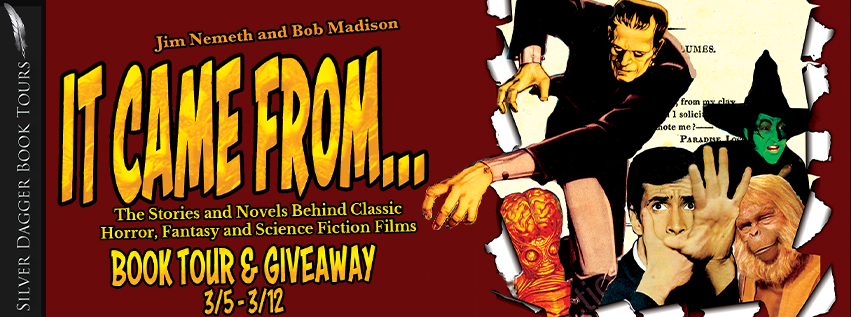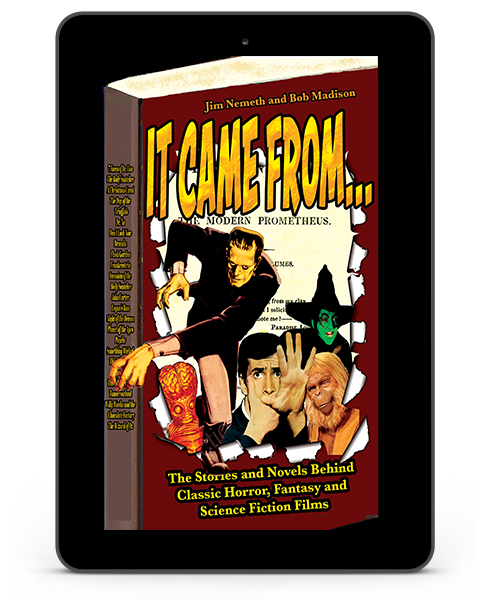The only book to completely examine the origins of classic fantasy films by including an in-depth
.
examination of the source material and its author, the screenwriter’s contribution in adapting it, and an
.
analysis of how that combination resulted in the production of the final film.
.
.
It Came From…
.
The Stories and Novels Behind Classic Horror, Fantasy and Science Fiction Films
.
by Jim Nemeth and Bob Madison
.
Genre: Film History, Horror, Fantasy, Science Fiction
.
How many times have you said, the book was better? And how many times was that actually true?
The cinema of the fantastic has benefitted from literary adaptations on a level unlike any other genre. With such brilliant authors as Mary Shelley, Robert Bloch, Pierre Boulle, Edgar Rice Burroughs and Robert Louis Stevenson to choose from, it’s no surprise that fantastic film shares its pedigree with literary fiction.
But do films never live up to their literary inspirations? Or are some movies just … better than the books that inspired them?
Join genre critics Jim Nemeth and Bob Madison for a rule-busting examination of 21 classic – and not so classic – horror, fantasy and science fiction films, and the classic – and not so classic – books that inspired them.
It Came From…The Stories and Novels Behind Classic Horror, Fantasy and Science Fiction Films will delight legions of movie buffs along with devoted readers of cherished fantastic fiction.
.
BearManorMedia ebook * Amazon Paperback * B&N * Smashwords * Goodreads
.

.
The Face Isn’t Finished: Invasion of the Body Snatchers (1956)
“There’s no emotion—none—just the pretense of it. The words, gestures, the tone of voice, everything else are the same—but not the feeling. He isn’t my Uncle Ira.” – Wilma Lentz, “The Body Snatchers.”
The loss of one’s self, one’s identity, everything that comprises who we are as individuals—not just our physical bodies, but our emotions, desires, passions, imagination, our essence—is a terrifying concept. Death, of course, is the ultimate such loss—the universal absolute. Some fight the inevitable tooth-and-nail, some are gracefully accepting, while the remainder of us fall somewhere in between. But ultimately, no one escapes their encounter with the Grim Reaper. Equally terrifying, to some more so, is a form of “living death:” the erosion of one’s mental faculties while still alive. Said degeneration can occur through such avenues as Alzheimer’s disease and dementia. Agonizing for all concerned, family and friends helplessly watch on as these diseases rob vibrant loved ones of their core humanity. Left behind is little more than an empty vessel, now devoid of the totality of what they had once been. A living zombie, of sorts. The only saving grace of such insidious afflictions is that there comes a point at which the victim mercifully becomes no longer aware of what is occurring.
This concept of stolen humanity is horrifying enough for occurring naturally. Now, image a scenario where something of unnatural origin—oh, let’s say an otherworldly alien—involuntarily robs you of your individuality and essence. Compound this horror further with the loss of your physical body, destroyed once duplicated, by aforementioned alien, thus easing its “recruitment” of family and friends in order to exponentially perpetuate an invasion no one suspects. Frightening, no? Writer Jack Finney imagined such a scenario, and his resulting tale, “The Body Snatchers,” first saw publication in 1954, serialized in Colliers Magazine. Hollywood quickly seized on the hot property and released Invasion of the Body Snatchers a mere two years later. The film is the first of four (to date) major cinematic adaptions of Finney’s tale.
Jack Finney (1911-1995), was born in Milwaukee, Wisconsin. After graduating from Knox College, he moved to New York City and worked for many years as an advertising copywriter. He married Marguerite Guest in 1949 through which they had two children. In the early 1950s, Finney and his family moved to Mill Valley, California, a small city a short distance north of San Francisco. Mill Valley would shortly become the inspiration for Santa Mira, the fictional locale where much of the setting for Body Snatchers takes place.
Finney’s writing career began in the 1940s, writing short stories and serials to such varied magazines as Collier’s, Cosmopolitan, Good Housekeeping, the Saturday Evening Post, and Ellery Queen’s Mystery Magazine. Finney’s writing during this period was most frequently within the thriller and light fantasy/science fiction genres. Finney later turned his hand toward writing novels when, during the 1950s there came a reduced demand for short stories in the magazine market. His first novel, 5 Against the House, which tells the story of several college students who set about an attempt to rob a nightclub in Reno, was published in 1954.
Later that same year, Finney wrote the story that would set him upon the path of success and later acclaim. Collier’s magazine published The Body Snatchers as a three-part serial in late 1954. Finney shortly thereafter revised and expanded the material, which subsequently saw publication as a Dell paperback novel the following year.
Finney granted few interviews throughout his life. As such, little is known regarding the author, let alone insights into his fictional works. However, in personal correspondence to famed horror author Stephen King in 1979, Finney wrote of his remembrances on the origin of his famous pod tale:
The book…was written in the early 1950s, and I don’t really remember a lot about it. I do recall that I simply felt in the mood to write something about a strange event or a series of them in a small town; something inexplicable. And that my first thought was that a dog would be injured or killed by a car, and it would be discovered that a part of the animal’s skeleton was of stainless steel; bone and steel intermingled, that is, a thread of steel running into bone and bone into steel so that it was clear the two had grown together. But this idea led to nothing in my mind…I remember that I wrote the first chapter-pretty much as it appeared, if I am recalling correctly-in which people complained that someone close to them was in actuality an imposter. But I didn’t know where this was to lead, either. However, during the course of fooling around with this, trying to make it work out, I came across a reputable scientific theory that objects might in fact be pushed through space by the pressure of light, and that dormant life of some sort might conceivably drift through space…and this eventually worked the book out.
.

.

.
Do you believe in writer’s block?
Oh, dear yes. During the writing of IT CAME FROM, I was hit with a severe case…that lasted nearly two YEARS! Block is bad enough when you can’t think of what to say, but in my case just the thought of TRYING to sit down and write was anathema to me. It took a very good friend (my co-author) to help me break through. He happily agreed to help me co-write the book and after I’d read a few chapters that he had written, I broke through my block and was able to resume with the book.
Do you prefer to write in silence or with noise? Why?
Silence…with a caveat. I’m very sensitive to noise—so many sounds upset me to a great extent. I’ve even self-diagnosed myself with having misophonia. And so, I couldn’t possibly write if buffeted by sounds. Except “white noise.” I have my Alexa device play white noise whenever I write.
Advice for new authors.
First and foremost, write for yourself. Write a story or book about what interests and excites you. Sometimes that will dovetail with what an audience or publisher is looking for, sometimes it won’t. I’ve found that if you write for someone else in mind or tackle a topic simply because it’s “hot” at the moment, you may ultimately be disappointed with the results.
What do you think about the current publishing market?
I fear the continued rise of AI. Already one can see the market being flooded with…may I say crap?…generated and “published” by non-talents hoping to make a quick buck. Worse, it increases the competition multi-fold and threatens to drown out actual, talented authors trying to make it in the business.
.

.
.
By day, Jim Nemeth is a technical writer within the fields of computer software and biotechnology.
.
As a professional writer, in 1993, Jim won 1st Prize in a national magazine’s short story writing contest for which novelists Ray Bradbury and Robert Bloch were judges. Winning held special meaning for Jim, as Robert Bloch remains his favorite writer and main literary influence. Jim has had essays, articles and reviews printed in a variety of magazines, including Filmfax, Mad About Movies, and Scary Monsters.
.
A long-time community activist, Jim is particularly committed to the causes of animal rescue and breast cancer research.
,
It Came From…: The Stories and Novels Behind Classic Horror, Fantasy and Science Fiction Films is his first book.
.
Born and raised in Chicago, Jim now lives with his husband in historic Marblehead, Massachusetts.
.
Website * Facebook * Amazon * Goodreads
.
Follow the tour HERE for special content and a giveaway!
.
.
.
.
~~~~~
Thanks so much for visiting fuonlyknew and Good Luck!
For a list of my reviews go HERE.
For a list of free eBooks updated daily go HERE
To see all of my giveaways go HERE.

















As a movie fan, this will be fantastic reading.
I think this is very interesting and super invested!
This sounds like a unique book that will interest fans of classic movies!
The book looks fun to read.
I would love to read your
This sounds like an entertaining read. Thanks for sharing.
Sounds fantastic